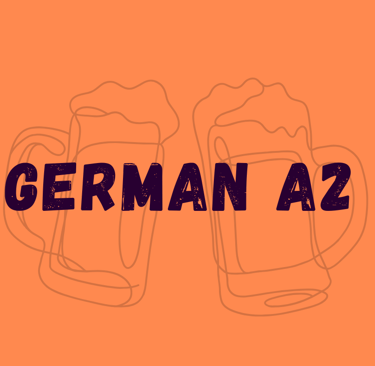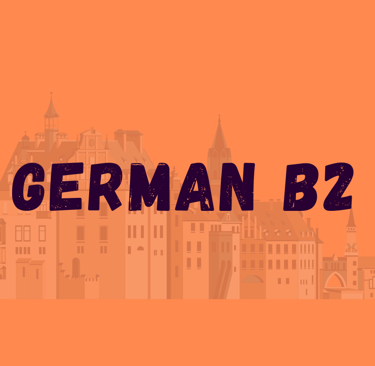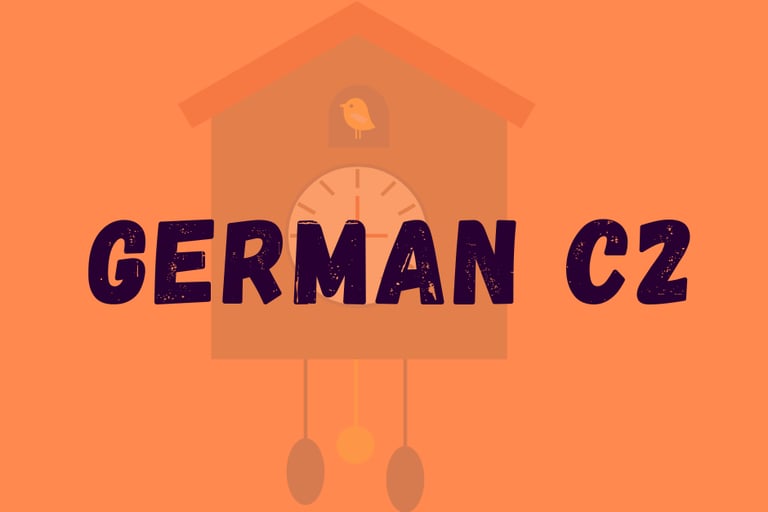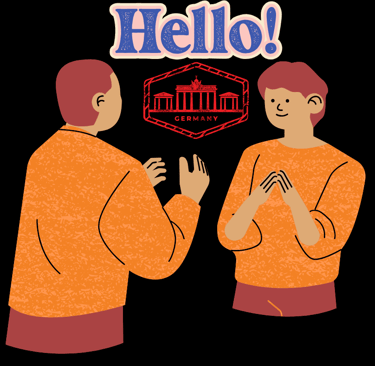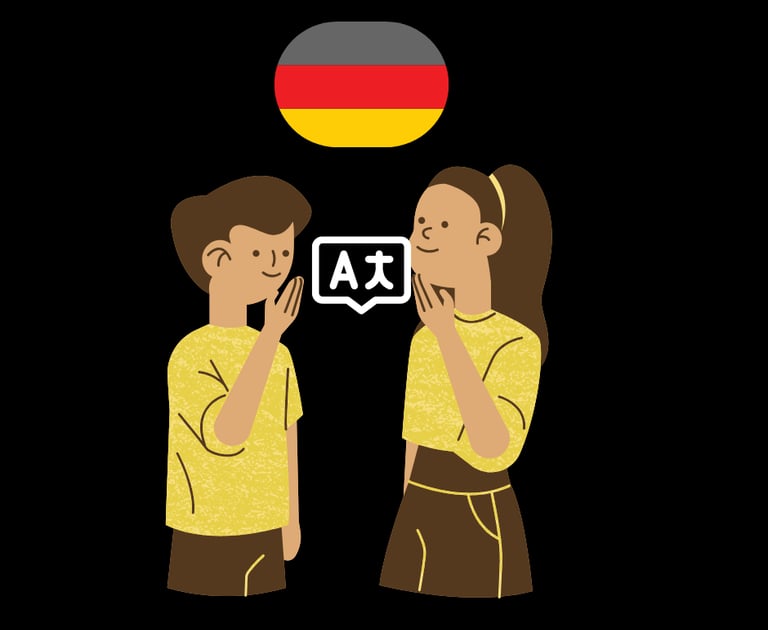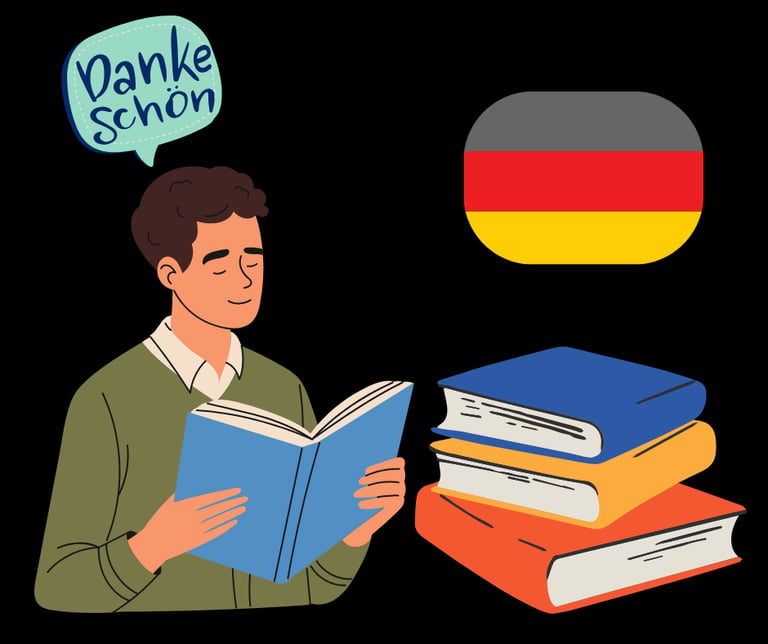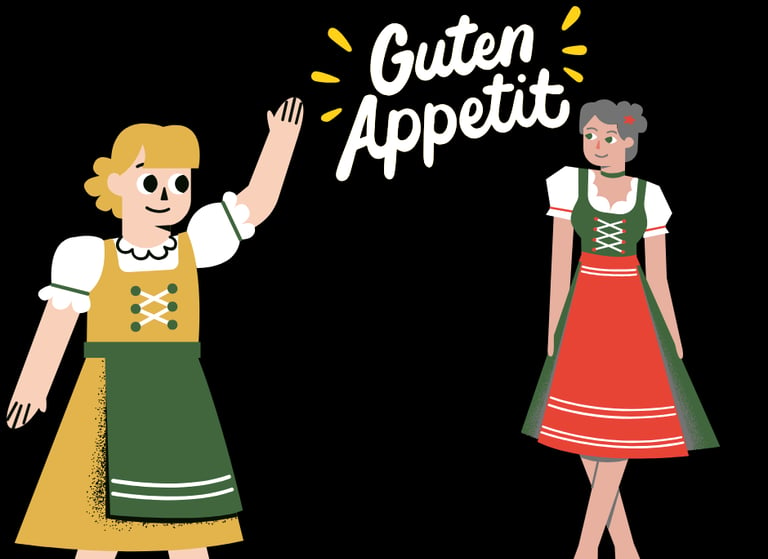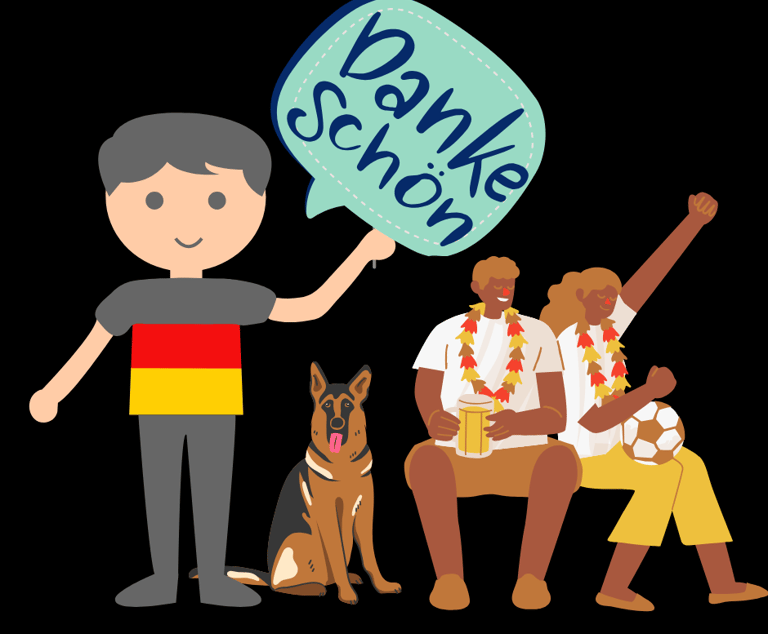German language
Learning German: it’s like leveling up in a video game, but instead of fighting dragons, you battle grammar rules and the mysterious gender of inanimate objects. The CEFR levels (A1 to C2) are your trusty roadmap—starting from “Ich bin ein Anfänger” (I am a beginner) all the way to “I dream in German and correct native speakers in my sleep.”
It’s not just about fluency—it’s about celebrating the little wins: like confidently ordering a pretzel without accidentally proposing to the baker. So buckle up, grab your Wörterbuch, and prepare for a wild ride full of laughs, surprises, and a lot of “Warum ist der Tisch männlich?!”
ROADMAP TO LEARN GERMAN LANGUAGE
🧭 What You Learn in German A1 (Beginner Level)
A1 = Survival German + Confidence Boost
At A1, you're learning to understand and use simple everyday expressions and basic phrases. You can introduce yourself, ask and answer questions about personal details, and interact in a very simple way — as long as the other person speaks slowly and clearly.
Let’s break it down:
📚 1. Vocabulary – Around 500–800 Words
You’ll cover essential words for everyday life, including:
Greetings & introductions (hello, goodbye, how are you, nice to meet you)
Numbers, days, months, time (telling the time, scheduling)
Family & relationships (talking about parents, siblings, friends)
Nationalities and languages (where you’re from, what you speak)
Professions (I’m a student, a teacher, a doctor...)
Weather and seasons (It’s sunny, it’s cold, etc.)
Colors and basic adjectives (big, small, old, new, beautiful, etc.)
Food & drinks (ordering, asking prices, talking about meals)
Shopping & prices (how much is this? I’d like to buy…)
Daily activities and routines (I wake up, I eat, I go to work)
Places in the city (bank, supermarket, train station)
Directions and locations (left, right, near, next to)
Basic verbs and actions (to go, to have, to be, to eat, to sleep…)
🧱 2. Grammar – Foundations of German Structure
You’ll learn to build simple but correct sentences using key grammar rules:
Personal pronouns (I, you, he, she, we, they)
Regular & irregular verbs in the present tense
The verb “to be” (sein) and “to have” (haben)
Simple sentence structure (Subject – Verb – Object)
Yes/no questions (Are you tired? Do you speak German?)
W-questions (Who, what, where, when, why?)
Articles (der, die, das) — gender basics!
Negation (not, no, don’t)
Plurals and possessive pronouns (my, your, his/her)
Simple use of prepositions (in, on, under, next to, at)
👂 3. Listening – Understanding Slow and Clear Speech
At A1, you’ll be able to understand short, simple dialogues when spoken slowly. You’ll practice:
Recognizing common words and expressions
Understanding basic questions and answers
Listening to announcements, introductions, or invitations
Picking up key info from a weather forecast, train schedule, or menu
You won’t catch every word — but you’ll get the main idea.
🗣️ 4. Speaking – Basic Everyday Conversations
You'll learn to introduce yourself and communicate simply, such as:
Saying your name, age, nationality, and profession
Talking about your daily routine
Ordering food in a restaurant or café
Asking for help or directions
Talking about your family, hobbies, and interests
Having basic conversations like:
“Where are you from?”
“What do you like to do?”
“What time is it?”
You’ll be using short, clear phrases — and gaining confidence every time you speak.
📖 5. Reading – Understanding Short Texts
You’ll practice reading:
Simple signs, ads, menus, and labels
Basic emails, text messages, or forms
Short dialogues or descriptions (about people, places, routines)
Instructions or notices (e.g. “No smoking”, “Open”, “Bus schedule”)
By the end of A1, you can scan for key info and read simple, functional texts with ease.
✍️ 6. Writing – Expressing Simple Thoughts
You'll learn to write:
Personal introductions
Short emails or postcards
Filling out forms (name, address, phone, etc.)
Simple sentences about your day, hobbies, or family
Shopping lists or plans for the week
You’ll be able to spell words, write short notes, and form simple paragraphs.
🌍 7. Real-Life Communication
At A1, you can now:
Greet people, say goodbye, and be polite in basic interactions
Ask for help in shops or at the station
Introduce yourself to new people
Handle basic travel tasks (buying tickets, checking into a hotel)
Survive in a German-speaking country for a short trip or stay
🎯 Why German A1 Is So Important
It gives you a solid foundation to build on
It lets you function in everyday situations
It prepares you for A2, where your sentences and ideas grow in depth
It helps you understand how the German language works
And it proves: You’ve started! You're on your way!
🧭 What You Learn in German A2 (Elementary Level)
A2 = Real-world German for everyday life.
At this level, you can handle basic social interactions, talk about your needs, and understand familiar topics — all in simple, clear German.
You’ll start forming longer sentences, and expressing more about your likes, dislikes, routines, dreams, and everyday challenges.
📚 1. Vocabulary – Around 1,000–1,500 Words
Your word bank grows — you now talk more easily about:
Work, jobs & daily tasks (talking about your workplace, job search)
School and education (subjects, learning, teachers, exams)
Health & the body (doctor visits, symptoms, simple emergencies)
Shopping for clothes & items (sizes, colors, returns)
Travel and transportation (tickets, schedules, booking hotels)
Food and dining (restaurant vocabulary, menus, dietary needs)
Describing people (appearance, personality, relationships)
Household topics (furniture, appliances, chores)
Leisure and hobbies (reading, watching films, music, sports)
Weather and seasons (more specific vocabulary)
Celebrations and traditions (birthdays, holidays, festivals)
You’ll also use more adjectives and adverbs to make your speech more detailed.
🧱 2. Grammar – Longer Sentences & More Precision
A2 helps you build more varied and accurate sentences.
Modal verbs (can, should, must, may)
Past tense (Perfekt) – for talking about what you did or what happened
Accusative & dative cases – with articles, pronouns, and prepositions
Sentence connectors (because, but, and, when, although)
Comparatives and superlatives (faster, more beautiful, the best)
Reflexive verbs (I get up, I wash myself, I feel good)
Separable verbs (e.g. “aufstehen” – to get up)
Word order in main and subordinate clauses
Questions & answers in various tenses
By A2, your grammar isn't just functional — it’s helping you speak more naturally.
👂 3. Listening – Conversations and Common Situations
You’ll be able to understand more details when people speak clearly.
You’ll recognize:
Simple conversations between friends, family, and colleagues
Telephone messages, announcements, and short interviews
Directions, instructions, and advice
Public service dialogues (e.g., doctor’s office, train station)
You’ll still need clear, slow speech — but you’ll start catching context and emotions too.
🗣️ 4. Speaking – Sharing Experiences & Making Plans
Now you're able to hold longer conversations, like:
Talking about your daily life, work, and routine
Describing past experiences and memories
Discussing future plans (travel, events, goals)
Asking for and giving opinions, preferences, and suggestions
Making appointments, small talk, or polite complaints
Giving directions, suggestions, or explanations
You'll start sounding like a confident beginner who can actually navigate life in German.
📖 5. Reading – Understanding Everyday Texts
You’ll be able to read:
Emails, notices, schedules, and ads
Short personal messages, like birthday greetings or invitations
Articles about daily life, hobbies, or travel
Basic descriptions, announcements, or instructions
You don’t just get the gist — now you’re understanding details too.
✍️ 6. Writing – Everyday Communication
A2 writing gets you comfortable writing simple texts, such as:
Emails and letters (invitations, apologies, questions)
Filling out forms with more details (name, job, reason for visit, etc.)
Short paragraphs about your experiences and feelings
Writing about past and future events
Describing your home, city, or job
You can now write a complete, clear, and polite message — in your own words.
🌍 7. Real-Life Communication – The Everyday You
By A2, you can:
Navigate life in a German-speaking country for work, study, or tourism
Handle conversations in shops, cafes, hospitals, and stations
Manage common social situations (small talk, giving opinions, asking for help)
Connect with people — and talk about real-life topics like family, feelings, and experiences
You’ll still make mistakes — but you can now hold your own in many day-to-day interactions.
🎯 Why German A2 Matters
It connects you to people and places in real conversations
You gain real-world German — usable, practical, and confidence-building
You’re ready to move beyond survival and into social interaction
It prepares you for the grammar and fluency boost in B1
Learning German is like assembling IKEA furniture—there’s a manual (CEFR levels A1 to C2), lots of oddly shaped parts (hello, compound words!), and a great sense of triumph when it finally clicks. Each level unlocks new skills: from ordering bratwurst like a local to casually quoting Goethe at dinner parties. It’s not just about fluency—it’s about the joy of making sense of long words, umlauts, and discovering that yes, Schadenfreude is both a word and a mood.
🧭 What You Learn in German B1 (Intermediate Level)
B1 = Independent Communication
At this stage, you can understand and express yourself in familiar situations at work, school, or during free time. You can tell stories, share ideas, and explain your opinions in German. You're more confident in both speaking and writing.
📚 1. Vocabulary – 2,500+ Words
Now you’re expanding your vocabulary beyond basics. You'll talk about:
Work & career topics (office language, interviews, responsibilities)
Education and learning (courses, exams, opinions on school systems)
News and media (TV shows, social media, newspapers)
Politics and society (basic current events, laws, voting)
Travel and cultures (planning trips, experiences abroad)
Relationships & emotions (feelings, arguments, romance, friendship)
Health and fitness (diet, exercise, mental wellness)
Technology (internet use, digital habits, devices)
Environment & sustainability (climate, recycling, green living)
Housing (renting, roommates, repairs, neighborhoods)
You also learn more nuanced adjectives, verbs, and phrases to describe thoughts and experiences more richly.
🧱 2. Grammar – Complex Structures, Still Manageable
Now grammar starts supporting your ability to explain, describe, and connect thoughts clearly.
Past tenses (Präteritum, Plusquamperfekt) – telling stories, background actions
Future tense (Futur I) – talking about plans and predictions
Passive voice (e.g. “The letter was written…”)
Relative clauses (who, which, that…)
Konjunktiv II – polite requests and hypothetical situations (“I would like…”)
Indirect speech (He said that…)
Extended use of modal verbs
Word order with multiple clauses (because, although, so that…)
You're not just making sentences — you're making connected, logical, flowing communication.
👂 3. Listening – Real Conversations and Media
At B1, you can follow main ideas and key details in spoken language, such as:
Interviews, podcasts, and radio shows
Discussions about work or study
Public announcements (at airports, stations, events)
People talking about plans, problems, or giving advice
You can now understand speech at natural speed, even if you miss a few words.
🗣️ 4. Speaking – Conversations That Feel Natural
You’ll be able to express:
Opinions, wishes, suggestions, and complaints
Talk about events in the past, goals for the future, and problems in the present
Describe experiences, trips, and personal challenges
Have debates on familiar topics like work, environment, health
Make requests, give advice, offer solutions
Use fillers and connectors to sound more natural
You can now have real conversations — and be understood even if you make mistakes.
📖 5. Reading – News, Opinions, and Real-World Texts
You’ll comfortably read:
Newspaper articles, blogs, interviews
Brochures, manuals, and advertisements
Essays, reviews, and opinion pieces
Instructions and longer narratives (e.g., short stories)
You won’t understand everything, but you’ll get the point and context easily.
✍️ 6. Writing – Opinions, Emails, and Narratives
Your writing at B1 will include:
Emails with detailed content (asking for information, applying for something)
Stories or narratives (your best trip, a bad day, a funny memory)
Reviews (a movie, restaurant, or product)
Arguments (explaining your position on a topic)
Reports and summaries (what happened, what someone said, what you think)
You’ll write clearly and with structure, using connectors and different tenses.
🌍 7. Real-Life Communication – Feeling Independent
With B1 German, you can:
Work or study in a German-speaking environment (with support)
Handle longer conversations at social events or on the phone
Make travel arrangements, discuss hobbies, and talk about the world
Explain problems and solutions in your own words
Express emotions and opinions in more than one sentence
This is the level where your German feels like your language.
🎯 Why B1 Is a Huge Milestone
You’re ready to live, study, or intern in a German-speaking country
You can handle a job interview or visa process
You’re no longer just learning — you're using the language
It’s the official level for German citizenship and many job applications
You’re ready for B2, where fluency starts becoming effortless
🧭 What You Learn in German B2 (Upper-Intermediate Level)
B2 = Professional and Social Fluency
At this stage, you can follow complex texts, understand abstract topics, and express yourself in a detailed, structured, and spontaneous way. You’re ready to function in a German-speaking work or academic setting.
📚 1. Vocabulary – Around 4,000–6,000 Words
Your word power grows into:
Professional & workplace vocabulary (meetings, negotiations, responsibilities)
Academic and formal language (studies, research, presentations)
Emotions & abstract concepts (freedom, honesty, conflict, success)
Debate and opinion vocabulary (advantages/disadvantages, consequences, solutions)
Politics & global issues (climate change, migration, economy)
Media, news, and trends
Literary and artistic topics (films, books, art, culture)
Social norms, taboos, and cultural customs
More idioms and expressions used by native speakers
You're not just understanding words — you're using them in precise and thoughtful ways.
🧱 2. Grammar – Flexibility and Finesse
At B2, grammar is no longer about survival — it’s about style, flow, and precision.
Passive constructions in multiple tenses
Konjunktiv I & II (for indirect speech and hypotheticals)
Subjunctive nuances (I wish, If I were, It would be better if…)
Extended use of relative clauses
Complex connectors (whereas, despite, although, as long as)
Mastery of word order in complex sentences
Nominalization (turning verbs into nouns for formal writing)
Reported speech, especially in media and academic contexts
You begin writing and speaking with more variation and elegance.
👂 3. Listening – Following Natural Speed and Depth
You can now follow:
Podcasts, radio, and TV shows at native speed
Lectures, presentations, and interviews
Detailed information from debates, discussions, or news reports
Subtle details like tone, emotion, and sarcasm
You’re not just catching the meaning — you’re following the intention behind what’s said.
🗣️ 4. Speaking – Expressing, Debating, Convincing
You’re able to:
Debate social or political issues
Express opinions with nuance (I partly agree, That depends on…)
Give structured presentations
Tell stories and anecdotes with expression and timing
Handle challenging conversations (complaints, disagreements, negotiations)
Adapt your tone depending on context (formal/informal)
In short: you sound like someone who really knows how to talk — in German.
📖 5. Reading – Diving Into Complex Texts
At B2, you’re reading:
Newspapers and magazines
Short essays and editorials
Abstract discussions (e.g., human rights, globalization)
Instruction manuals, contracts, and official letters
Novels and literary excerpts
You’ll be able to analyze the structure and meaning, not just the words.
✍️ 6. Writing – Structured, Clear, and Professional
B2 writing includes:
Formal emails and letters (inquiries, complaints, applications)
Essays and opinion pieces
Summaries of articles or lectures
Reports (with comparisons, analysis, and conclusions)
Short stories or reflections using literary techniques
You're using connectors like deshalb, jedoch, trotzdem, obwohl — and your writing has flow and clarity.
🌍 7. Real-Life Communication – Fully Functional
At B2, you can:
Work in a German-speaking environment with confidence
Join meetings, group discussions, and team projects
Socialize with native speakers without fear or frequent gaps
Understand and talk about politics, news, and opinions
Apply to university programs, internships, or job interviews
You’re no longer just reacting — you're actively participating.
🎯 Why B2 Is a Big Deal
It’s the level most universities and employers expect
You’re ready for living abroad in a German-speaking country
You can work, study, debate, and collaborate in German
You understand not just the words, but also the culture and context
It’s the perfect foundation for C1, where mastery begins
🧭 What You Learn in German C1 (Advanced Level)
C1 = Academic, Professional, and Cultural Proficiency
At this level, you understand and produce complex language. You can talk confidently, spontaneously, and effectively in almost any situation — work, university, presentations, social life. You're comfortable dealing with unfamiliar topics, expressing nuanced opinions, and understanding subtext.
📚 1. Vocabulary – 7,000+ Words and Growing
You're not just learning words — you're learning concepts, idioms, tone, and register. Your vocabulary includes:
Academic and scientific terms (research, theories, analysis)
Professional and technical language (depending on your field)
Art, literature, film, and philosophy vocabulary
Emotional and psychological expressions (doubt, regret, uncertainty)
Business and economics (markets, strategy, finance)
Legal and administrative terms (contracts, rights, obligations)
Political and cultural discourse
A wide range of idiomatic phrases and fixed expressions
You know when to sound casual, when to sound formal, and how to adapt your tone.
🧱 2. Grammar – Mastery and Nuance
By C1, grammar is your toolbox. You know what to use, why to use it, and how to do it naturally.
Full command of all verb tenses and moods, including:
Konjunktiv I & II (for expressing doubt, indirect speech, hypotheticals)
Passive voice in all tenses
Relative and subordinate clauses with ease
Participles as adjectives and in complex sentence constructions
Mastery of noun and verb formation through prefixes and suffixes
Complex prepositions and adverbial phrases
Skillful word order, even in dense and layered sentences
You’re creating elegant, flowing, and logical structures that reflect your thoughts precisely.
👂 3. Listening – Natural Speed, Native Detail
At C1, you can understand nearly everything you hear in German, even when:
The speaker speaks fast or uses dialects
The topic is abstract, technical, or philosophical
You’re watching films, debates, documentaries, or radio interviews
You understand tone, irony, sarcasm, and implied meaning, not just the words.
🗣️ 4. Speaking – Fluent, Structured, Expressive
You can now:
Speak spontaneously and fluently, even on complex topics
Use a wide range of connectors, transitions, and idioms
Present arguments and counterarguments smoothly
Lead professional discussions, negotiations, or interviews
Express subtle shades of meaning (doubt, critique, humor, etc.)
Adjust your speech for formal or casual settings
You’re not just speaking correctly — you’re speaking with confidence, clarity, and intention.
📖 5. Reading – Deep Understanding of Complex Texts
You can now comfortably read:
Academic texts and research papers
Literary works (novels, poetry, essays)
Formal documents (contracts, legal documents, policy)
News analysis, editorials, and specialist articles
Philosophical and theoretical writing
You grasp main ideas, supporting arguments, and author's intention, even when it’s subtle or abstract.
✍️ 6. Writing – Precise, Polished, and Professional
Your writing at C1 can include:
Well-structured essays with arguments and examples
Formal reports and analyses
Proposals, project outlines, and emails in a professional tone
Summaries and commentaries on texts or events
Creative writing with rich vocabulary and varied sentence structure
You write with clarity, elegance, and appropriate register (formal/informal), depending on the task.
🌍 7. Real-Life Communication – Full Integration
At C1, you can:
Work or study full-time in a German-speaking country
Take part in academic discussions and give presentations
Understand and participate in cultural and social discussions
Write university-level assignments
Function at a professional level in nearly any environment
You're not just fluent — you're operationally proficient.
🎯 Why C1 Is a Game-Changer
You can work in professional roles in German
You can attend university courses taught in German
You are considered fully independent and advanced
C1 is the level for teachers, translators, researchers, and leaders
You understand humor, irony, and cultural references
You're officially a serious user of the language — someone who belongs in any room, any discussion, any debate.
GERMAN LANGUAGE A1
GERMAN LANGUAGEA2
GERMAN LANGUAGE B1
GERMAN LANGUAGE B2
GERMAN LANGUAGE C1
GERMAN LANGUAGE C2
🧭 What You Learn in German C2 (Mastery Level)
C2 = Mastery
At this level, you can effortlessly understand virtually everything you hear or read, summarize information from various sources, reconstruct arguments, and express yourself with precision, sophistication, and subtlety — both spoken and written.
📚 1. Vocabulary – 8,000–10,000+ Words
Your vocabulary is rich, refined, and flexible across every context:
Advanced academic and professional language
Specialized vocabulary for fields like law, medicine, engineering, or philosophy
Cultural and literary references
Sophisticated idiomatic expressions and regional variants
Mastery of synonyms, tone, register, and nuance
Ability to play with style: formal, ironic, poetic, sarcastic, diplomatic, etc.
You can express exactly what you mean, with the perfect words — even if it’s something deeply abstract or emotionally complex.
🧱 2. Grammar – Intuitive and Effortless
At C2, grammar becomes second nature. You don’t think about it — you use it fluently, even in emotionally or intellectually demanding situations.
You master:
Multiple embedded clauses (with seamless transitions)
Nuanced use of Konjunktiv I & II
Advanced nominalization and passives
Cleft sentences for emphasis (e.g., "Es ist der Klimawandel, der die größte Herausforderung darstellt")
Artistic variation of sentence style and rhythm
Perfect command of register (switching between casual, academic, poetic, etc.)
You can mimic the style of a novelist, a news anchor, a politician, or your favorite grumpy professor.
👂 3. Listening – Nothing Is “Too Fast” Anymore
You can understand everything:
Rapid, overlapping conversations
Academic lectures and symposia
Films, podcasts, audiobooks with complex narratives and layered meaning
Subtle emotional undertones, humor, irony, sarcasm
You’re not just catching the meaning — you’re hearing the intent, subtext, and personality behind the words.
🗣️ 4. Speaking – Persuasive, Expressive, Native-Like
You now speak:
Spontaneously, with elegance and coherence
With precision, wit, and stylistic variation
Using metaphors, humor, rhetorical devices, and even irony
Comfortably in any context — from academic panels to impromptu toasts
You can lead complex discussions, resolve misunderstandings, and influence decisions — in a natural, native-like way.
📖 5. Reading – Any Text, Any Topic, Any Time
You can read and analyze:
Academic journals, research papers
Classic and modern literature
Legal and political documents
Philosophical and theoretical writing
Satire, poetry, literary reviews
You can interpret themes, intentions, historical context, and even hidden meanings with depth and insight.
✍️ 6. Writing – Professional, Academic, Creative Mastery
You can write:
Academic papers with argumentation, structure, and citations
Speeches, essays, and articles for publication
Formal reports, proposals, and business correspondence
Literary compositions — poems, stories, reflections
Personal letters, reflective pieces, or critiques — tailored to your audience
You write with clarity, style, depth, and subtle control of tone.
🌍 7. Real-Life Communication – Native-Level Operation
At C2, you can:
Work as a university professor, journalist, lawyer, or diplomat in German
Live, study, and thrive in any German-speaking country
Function at a native level, even in emotionally or intellectually intense discussions
Understand all cultural references, media, humor, and regional quirks
Translate and interpret between German and your native language
You’re not just fluent — you’re an advanced user, thinker, and creator in German.
🎯 Why C2 Is the Linguistic Crown
You’ve reached complete fluency
You can think, work, and create in German
You’ve crossed from language learner to language master
You can now teach, translate, publish, and influence
You're fully culturally immersed and linguistically free



